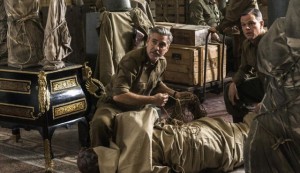By Katherine Burke
Correspondent
If you’re like me, you’ve seen quite a few historical movies set in World War II throughout the last few years.
Hollywood producers have discovered that magical and secret formula for a blockbuster: inject a few over-the-top explosions, a leading man or two and just enough history to make the viewer feel like they know just a little bit more about the subject. Then, there are the movies that are loosely based upon a book of the same name.
If you’ve been watching TV at all in the last few weeks, you’ve probably seen the ads for the newest WWII film, “The Monuments Men,” based on the book “The Monuments Men: Allied Heroes, Nazi Thieves, and the Greatest Treasure Hunt in History” by Robert M. Edsel.

As seen within the advertisement featuring the forever handsome George Clooney, “The Monuments Men” is about a special force of American and British artists, curators and historians between D-Day and V-E Day, attempting to save the world’s art from the clutches of Hitler and the Nazis.
During the war, Hitler dispatched forces to find and hoard the finest art in Europe, with the intention of creating the greatest collection the world has ever known.
However, those same commercials do no justice to the exemplary writing that is “The Monuments Men.” Rather than a duck-and-cover adventure story, Edsel follows the lives of several men and women dedicated to the preservation of art, culture and society during WWII.
With each chapter following the experiences of a different Monuments Men, the book is much less action-adventure than the film seems to be. Rather than working as a rag-tag group, most of the men work alone.
Though that may be a letdown for some, Edsel captures each person’s struggle to preserve thousands of years of history. Scattered throughout the entirety of Europe, these men were responsible for a task that was often deemed insignificant in terms of the larger picture of war.
Edsel also does justice to largely significant moments in history. His descriptions of the horrors and destruction that these men faced as part of their everyday lives within a warzone forces the reader to become emotionally invested with not only just these men, but the works of art they attempt to save. By including snippets of their lives outside of the war, the readers find themselves invested in the success of the mission.
Even more interesting is Edsel’s treatment of the men and women that assisted “The Monuments Men” along their journey. Most notable is the calm and secretive Rose Valland. Proving to be one of the greatest tools for the American men dedicated to saving the precious art and culture of Paris, she remains a constant within the text.
It also reminds the reader that the support of the people “on the ground” was invaluable and vital to the support of the mission as a whole.
In short, “The Monuments Men” looks to be a great film — if not exactly what the book details — and is an even better story. Even if history isn’t your thing, give it a whirl. It will definitely open your eyes to the harrowing struggles that a small group of people went through to save the most precious parts of humanity during a tragic time.






